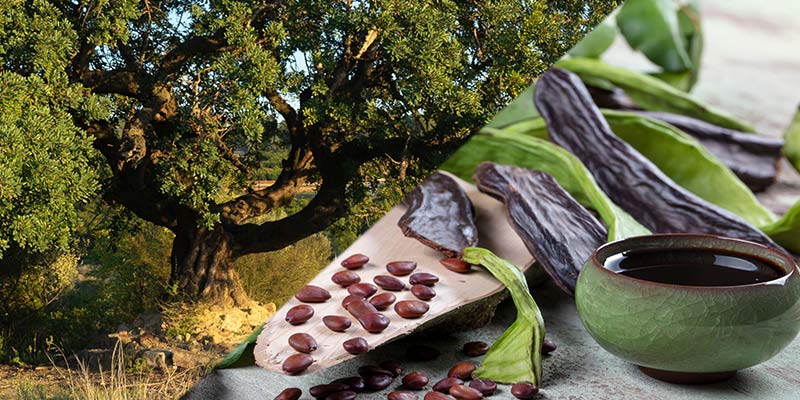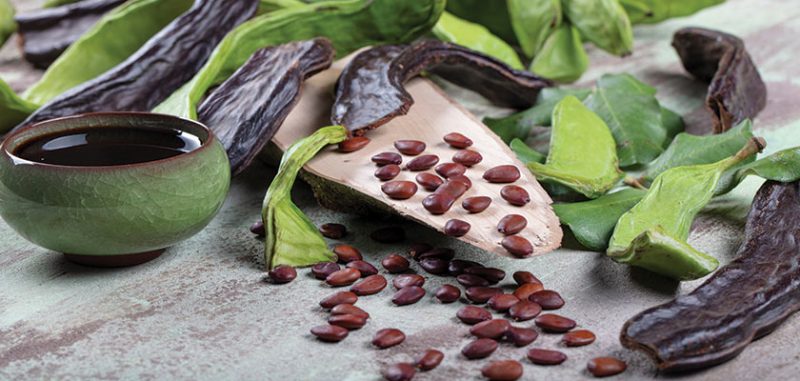Want to grow your own carob harvest at home? Today, we explain how and where to find a carob tree for sale in the USA, plus carob growing, harvesting and drying guidelines.
Carob is a healthy and sustainable alternative to chocolate, that continues to grow in popularity. Gone are the days of chalky carob “chocolates” – today’s carob treats are well-crafted and delicious sweets in their own right.
If you have the yard space and the right climate, a carob tree is a great long-term investment. It is a long-lived tree, that can withstand the harsh conditions of our increasingly unpredictable climate. They can withstand poor soils and drought, and are excellent shade trees. And of course, they give us precious carob pods to enjoy and make into our own homemade carob chocolates.
In this guide, we explain how to grow carob and where to find a healthy carob tree for sale in the USA, that you can use for your own carob supply, plus carob harvesting and drying tips.
How to Select a Quality Carob Tree for Sale
Tips for Finding a Good Carob Tree for Sale
Store Reputation. When searching for a good quality carob tree for sale, choose nurseries or online suppliers that have a good reputation and specialise in fruit trees.
Ask for Shopkeepers Advice. Pick the brains of the carob tree specialist at your chosen nursery or online store. Find out all you can about the best location for planting, how to plant and how to bring on a young tree.
Pick the Right Size. There are several different varieties which grow from 5 m to 10 m high, so when choosing a carob tree, pick the right size for your plot.
Look for Healthy Foliage and Roots. Give your carob tree the best chance of success by choosing saplings with healthy foliage and a well-developed root ball.
Look for Pests. Check over the foliage and branches for any signs of pests or diseases.
How Many Carob Trees Do You Need?
If you want to harvest carob pods, you will need two trees: 1 Male, 1 Female.
The carob tree is unusual in that it has separate male and female trees; this is termed being dioecious. It is only the female tree that produces fruit, so ensure you get the right sex tree when you purchase. The flowers on the female tree are small and yellow with an aromatic fragrance, while the male flowers have an unpleasant aroma.
Both male and female trees are required to produce fruit, and without access to pollen from the male carob tree the female tree will not set fruit. Good nurseries will label the pots with sexes, so you know which ones you are getting. When choosing carob trees for sale online, make sure you have the option of choosing the sexes, or contact them to ask.
In commercial carob cultivation, for every 25-30 female trees, a single male tree is planted among them to achieve cross-pollination. Alternatively, some southern European growers graft branches cut from male trees onto female trees to achieve the same effect.

Where to Find Carob Tree for Sale in the USA
Reputable Nurseries with Carob Trees for Sale (USA)
Below is a list of nurseries in the USA with quality carob trees for sale, at the time of writing. Please be mindful that this is a general guide only, and stock may change at any time without notice. For the most up-to-date information and carob tree sale prices, contact the nursery directly.
Of course, this is not an exhaustive list. Check with your local nursery first to see if they have a carob tree for sale, before going online. Generally, local trees will be better acclimatized to your region than ones ordered online from the other side of the country, so if you can find a healthy carob tree for sale locally consider that as your first option.
Are you a nursery that would like to be listed? If so, please contact us.
| Nursery | Website URL | Location |
|---|---|---|
| Moon Valley Nurseries | https://www.moonvalleynurseries.com/carob | Franklin TN |
| Sugar Hill Nursery Florida | https://www.sugarhillnurseryfl.com/product-page/ceratonia-siliqua-carob | North Central FL |
| One Green World | https://onegreenworld.com/product/carob-tree/ | Portland OR |
| Treeland | https://www.treeland.com/products/trees/evergreen-trees/broadleaf-evergreen-trees/carob-tree-or-st-johns-bread-ceratonia-siliqua/ | Mesa AR |
Will carob trees for sale online survive in my garden?
If you’ve never purchased plants online, naturally you may be sceptical about whether your carob tree can survive the postal journey. Online suppliers are well-experienced in shipping saplings, and have worked out solutions for this.
They are generally shipped with the root ball intact but sometimes without soil. The root ball is soaked in water and allowed to drain, and bare roots are covered with damp sawdust. A plastic covering is tied around the root to ensure the sapling has enough moisture for transit. The trunk of the sapling can be splinted with a pole for support before the whole sapling is wrapped in cushioned plastic wrap.
On arrival, saplings don’t need to be planted immediately. Remove the outer wrapping to expose the root ball, and place the sapling in a bucket with about half an inch of water in the bottom. If necessary, add some extra organic matter or compost to provide support for the sapling until it is planted out.
How to Successfully Grow Carob Trees
The history of carob cultivation is well documented, with mentions even in the Bible throughout its 4000-year history in the warmer Mediterranean climates of Morocco, Italy, and Portugal. The popularity of the tree grew, and it was Spanish explorers who introduced carob cultivation to South America and Mexico in 1854. From here, cultivation spread to other subtropical states, including Arizona, Florida, California, and Texas. The trees thrived in the warm, dry conditions, with many planted as ornamentals and to line the streets of towns.
Ideal Conditions for Growing Carob Trees
Soil and Location
Carobs thrive in well-drained soil which has a neutral to slightly acidic pH. They can adapt to various soil types, including sandy or loamy soils. To produce a good fruit crop, the trees need plenty of full sun, so avoid locations that might cast a shadow on them. The carob tree is part of the legume family, similar to the pods of peas and beans.
Planting
To give a young tree its best chance of rooting, it’s best to plant in the spring after the last frost. Dig a hole that is as deep as the root ball of the tree with a circumference that is twice as wide. Water the hole liberally and put the tree root in position. Check the top of the root ball is at the same level as the top of the surrounding hole. Replace the excess soil around the root ball and gently use your foot to secure the tree in place, but don’t compact the soil. Thoroughly water the soil around the tree base.
Even once the carob tree is well established, it is still important to occasionally water it thoroughly during its first few years while it establishes its root structure. Don’t be tempted to overwater; the roots can flood, resulting in root rot. Once established, the tree becomes drought tolerant, with its root system penetrating deep enough to locate water. The carob can tolerate frost down to 20° F (-7° C), but ideally, this is best avoided by using frost protection.

Feeding
Carob trees don’t need regular fertilising, but one annual application will certainly help to promote root and branch growth, as well as give the best chances of a healthy fruit crop. A good all-purpose liquid fertiliser is ideal, although some growers prefer to use homemade organic fertiliser like compost or aged manure.
Pollination
Flowers are produced by carob trees in late summer and early autumn. The flowers are distinct, with the male ones producing a powerful, unpleasant odour which insects love. In collecting the nectar, the insects also pick up pollen on their legs, which is transferred to female flowers on other trees as they continue feeding. This is insect pollination.
Pollen transfer from a male tree to a female via the wind is also a common pollination route.
For the small-scale carob grower, where growing a male and a female tree directly next to each other isn’t possible, it is best to wait and see if the female is naturally pollinated by insect or wind pollination. For this to work, there still needs to be a male tree within the vicinity.
If this doesn’t work, hand pollination could be the answer. This necessitates finding a flowering male carob tree and using a pollen brush to collect pollen from the anthers, which can then be transferred to the stigma of the female tree.
Diseases and Pests
After a few years, once carob trees are established, they should become hardy to infestations of pests or diseases. However, it’s always worth making a periodic check to see if there are any wilted or sticky leaves that may be harbouring aphids, scale insects, or mealybugs that have taken up home. All three pests feed on the carob tree sap which can weaken the tree, so it is good to nip any outbreak in the bud.
Problem insects
Aphids, scale insects, and mealybugs can be removed simply with cotton wool soaked in alcohol or a cup of alcohol in a spray bottle diluted with a quart of water and a few drops of liquid soap. Spray the infested branches and leaves thoroughly.
Fungal diseases
Carob trees can also be attacked by powdery mildew and black spot. Both are fungal diseases which have many species. They are very common throughout the plant kingdom. Powdery mildew appears as a dusting of white powder which covers the leaves, stems, and flowers of the tree.
Black spot takes the form of black patches or spots on leaves. It is straightforward but time-consuming to remove affected vegetation by hand or choose a chemical treatment using a sulphur fungicide.
Pruning
Late in the year or before new growth, the following year, remove any branches that are dead or showing signs of disease. This helps the tree optimise nutrients for the living sections. Cut carob branches tend to lose a lot of sap so prune conservatively.
How to Harvest & Process Carob Pods
Carob pods are valued for the pod casing and the sweet pulp inside, which surrounds the carob seeds lining the pod. Historically, the consistent weight of carob seeds made them ideal for weighing gold, and from where it is thought, the word carat derives. However, for carob-lovers, the real gold is the sweet pod casing and pulp, which we will focus on in this section.
When to harvest carob pods
Carob trees rarely produce fruit until they are between 3-6 years old, but on the upside, trees easily last for 100 years in the right conditions. The distinctive pods take almost an entire year to grow, starting out green and gradually turning brown until they are ready for harvest in September onwards.
How to harvest carob pods
Harvesting the pods by hand is common, but depending on the size of the crop, this can be arduous. Some growers prefer to leave the pods until extra ripe when vigorous shaking of the tree trunks easily dislodges them.
How to process carob pods (drying)
The processing of the pods varies depending on the desired final product. However, the process typically involves washing the pods before they are coarsely ground or kibbled. This makes separating the seeds from the surrounding pulp easier.
The seed pod cases containing the pulp are then roasted and finely milled to create carob powder or its commercial name, locust bean gum. Similarly, but without roasting, the carob pod seeds are also finely ground to create locust bean flour.
Conclusion
We hope you’ve enjoyed this article on how to grow and where to find a carob tree for sale. Carob is a healthy substitute for chocolate, which has been associated as a treatment for many different medical conditions. If you have the yard space and are willing to invest in a long-term food crop, them carob is a fantastic choice. Not only is it excellent for making carob treats, but it is highly nutritious, hence it’s other name St Johns Bread. It’s also a great tree, and excellent fire break tree in areas that are prone to wild fires.
When seeking a carob tree for sale, in the first instance try to find one from a local nursery, as it will be better adjusted to your regional microclimate, than one purchased online. However, there are also many reputable online nurseries with carob trees for sale, that can supply you with a tree if you can’t find one locally. If you are interested in learning more, you can check out our article what is carob or learn to make your own carob chocolates at home using traditional chocolate-making principles.
Happy carob-tiering!





